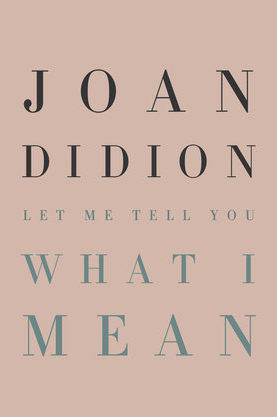Let Me Tell You What I Mean
by Joan Didion
reviewed by Maia Silber
In a lecture she gave at the University of California, Berkeley, in 1976, Joan Didion recalled her own undergraduate days at the school. In seminars, she said, she struggled to concentrate on Paradise Lost and “the Hegelian dialectic,” finding her mind wandering instead to the Bevatron laboratory she could see from her classroom window. She was not, she assured her audience, thinking about the military-industrial complex, but simply “wondering if the lights were on.”
Like all episodes in the Didion mythos—the pioneer ancestors who parted ways with the Donner Party on the trail, the girlhood crush on John Wayne, the attacks of vertigo and nausea in the summer of ’68—the memory is precise, perfectly crafted, and not to be entirely trusted. The story Didion tells about her development as a writer in the new collection Let Me Tell You What I Mean is a story of naïve craftmanship: Didion as a “collector of verbs,” a scavenger of images, innocent of their meaning. She is not “an intellectual.” Not political.
Of course, she is both. Didion’s early writing reflected not only her stylistic innovation but her search for an alternative to what she considered the compromised ethic of her era’s mainstream press. Besides the statements on writing, the collection includes several essays originally published in Didion’s Saturday Evening Post column in the 1960s. The magazine, famous for Norman Rockwell’s cover illustrations of domestic tranquility, had reached its apogee in the early postwar years. By the sixties, it was struggling, its brand of middlebrow sentimentalism increasingly losing cultural ground. Editorial experimentation borne of financial desperation, according to biographer Tracy Dougherty, gave Didion a surprising degree of free reign. In her column, she excoriated the clubby, politically timid journalism exemplified by the magazine itself: “newspapermen [who] are no longer adversaries but are confidants” of powerful men. She praised the radical underground papers of Berkeley, which at least made no pretense to the “quite factitious ‘objectivity.’”
Didion objected to Cold War media culture on purportedly aesthetic, rather than ideological, grounds: mainstream newspapers were “deadening” and left her with “unpleasant agrarian aggressions.” Yet her critiques of the political establishment—and the journalists who supported it—were no less withering than those of the overtly partisan Berkeley Free Press. Didion’s typical method was to attend a press junket designed to produce puff pieces, ignore its advertised subject, and turn her attention to the obsequious journalists who participated in the charade. Profiling Nancy Reagan during her husband’s tenure as governor of California, Didion summarizes her interview with the state’s first lady in a paragraph but dwells on a cameraman’s blundering attempt to stage a shot of her trimming a rhododendron bush. “Fake the nip,” she quotes the desperate cameraman. “Fake the nip.”
The vapidity Didion mocks in her profile of Nancy Reagan takes on a tragic register in an essay on a military reunion, “Fathers, Sons, Screaming Eagles.” Didion begins in her familiarly sardonic tone, observing that “the wives had pretty dresses, and everyone liked Las Vegas.” A colonel promises an audience of World War II veterans that operations in Vietnam have been “characterized by high esprit, rugged determination,” just like their own youthful “adventures.” Didion ends the essay with the quiet grief and confusion of a veteran contemplating his son’s possible deployment, wondering if the war might not be “such a great adventure” after all. “My only advantage as a reporter is that I am so physically small, so temperamentally unobtrusive, and so neurotically inarticulate that people tend to forget that my presence runs counter to their best interests,” Didion once wrote. If her inconspicuous presence let her report an anti-Vietnam story at a military reunion, then her feint of writerly innocence let her publish it in The Saturday Evening Post.
Later in her career, Didion found that she did not need to attend the press events. Journalists, she wrote in Political Fictions, would trade anything for “access.” But campaign memoirs and carefully crafted statements, read carefully and critically, could reveal more than the coveted insider’s tips. An essay on Martha Stewart models this method in Let Me Tell You What I Mean. Didion mocks a biography gushing with “investigative juices” that claimed to puncture the myth of Stewart’s image as a perfect housewife by documenting her temper tantrums and tirades against staff. Stewart’s fans, Didion argues, were under no illusion that their icon was a model of “Fifties-style homemaking.” Stewart marketed herself not as a domestic “Superwoman” but as a capitalist “Everywoman” whose appeal lay in her promise that traditional skills could yield financial gain.
Didion claimed that she learned little from Berkeley’s English Department. Yet her journalism often took the form of a sort of literary close reading, picking apart the political and cultural narratives that the mainstream press uncritically replicated. Her craftsman’s ability was also the ability to recognize shoddy craftsmanship, a master mythmaker’s eye for dubious myths. Even as she constructed her own perfect images, she dismantled the scenes constructed for the benefit of the press—those nipped rhododendrons—and mistaken for a glimpse behind the curtain. In her new collection, Didion does not always tell us what she means, least of all about her own writing, but she does show us. More than just a collector of verbs, she was an astute critic of the mid-century press, who cared about much more than the lights on in the Bevatron.
Published on March 30, 2021

